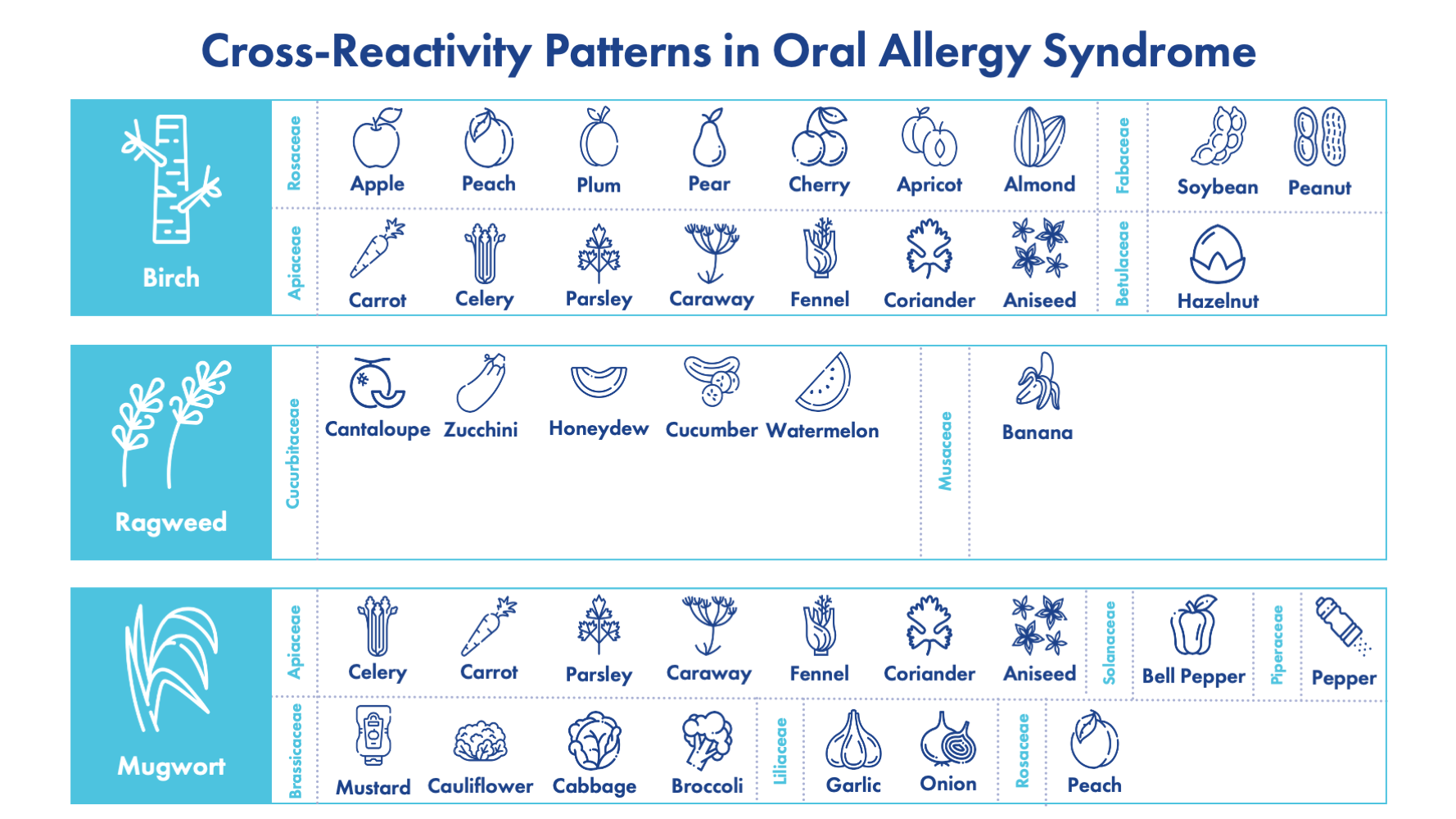4 Questions On NAD/NADH Testing Answered
Unlocking the Secrets of Cellular Energy
4 min read
![]() Dr. Chris Meletis, ND
:
July 21, 2020 at 4:03 PM
Dr. Chris Meletis, ND
:
July 21, 2020 at 4:03 PM

When the allergy season arrives, many patients are focused on avoiding pollen from trees and grasses. Yet, they're not always aware of an important fact—if they're reacting to tree and grass pollen, they are also are likely reacting to specific foods as well. And if they're eating those foods at the same time as they're suffering from hay fever, they're only going to make their pollen-related allergies worse.
The fact that people who are allergic to pollen also have allergy symptoms when exposed to certain food groups is known as cross-reactivity. The same situation occurs in people who are allergic to latex—they also react when exposed to related food items.
It's estimated that four to eight percent of the population suffers from overt food allergies. Not all food allergies are pollen or latex related—some can be acquired through a direct sensitization over the gastrointestinal tract—but most food allergies in adolescents and adults are acquired due to cross-reaction to pollen allergens. These pollen allergens are found in a variety of fruits and vegetables, causing many pollen-allergic patients to acquire many different plant food allergies. They may even react to foods they've never eaten before.
In adults, up to 60 percent of all food allergic reactions occur because of cross-reactions between food and pollen.
Cross-reactivity occurs when IgE antibodies in the body are able to recognize similar (homologous) allergens from different species that share the same epitopes.
Profilin is the primary allergen found in birch, grass, and other pollens. It's also found in many plant foods.
The family of lipid-transfer proteins (LTP) is also responsible for the cross-reactivity between many foods and pollen. LTPs also are responsible for the systemic symptoms that occur in food allergy patients. Researchers have identified allergens from this family in most vegetables and fruits.
75 percent of patients who suffer from peach allergy recognize the peach LTP, known as Pru p 3, which is to blame for food cross-reactivities—especially those related to fruits and nuts—as well as pollens from mugwort and plane trees.
Knowing which foods cross-react with pollen sources and latex is critical for diagnosing patients and improving the treatment of their allergies.
The cross-reactivity between fruits, vegetables, and pollen that occurs in hay fever sufferers is also called oral allergy syndrome, due to the fact that many of the symptoms that occur after consuming an offending fruit or vegetable occur in the mouth, lips, tongue, and throat. There is some indication that the symptoms occur more often after consuming uncooked fruits and vegetables, and that consuming the foods cooked does not result in symptoms in some subjects.
In other cases, the reaction to the offending food is more severe. Regardless of whether a food is raw or cooked, some patients consuming a cross-reacting food will go into anaphylactic shock. And some patients who have pollen-related food allergies also have gastrointestinal symptoms.

In the Western developed world, birch pollen allergy is the form of allergic rhinitis most likely to be accompanied by food allergies. Up to 80 percent of people who suffer from birch pollen allergies also have food allergies.
Chances are good that if someone is allergic to birch pollen, they'll also react to hazelnuts and apples, which are the most common allergenic foods in this group of people.
Soy can also cause problems, and some birch-pollen allergic patients have gone into anaphylaxis after exposure to soy.
Common Cross-Reactions Between Pollen and FoodBirch Pollen: apple, carrot, celery, pear, tomato, cherry, tree nuts Goosefoot Pollen: banana, melon, peach (infrequently: nectarine, asparagus, kiwi, potato, olive, onion) Mugwort Pollen (Weed): carrot, celery, aniseed, peach Ragweed Pollen: melon, cucumber, banana, sunflower, echinacea Timothy Grass: apple, litchi, tomato, celery, corn, bell pepper, paprika Source: www.foodintolerances.org |
For many people, birch-related food allergies don't go away when allergy season is over. Most experience food-related symptoms outside the birch pollen season, indicating that homologous food allergens cause a continual increase in birch-pollen-specific immune responses.
On-Demand Webinar: Demystifying Allergic Cross-Reactivity
Allergy to latex is common and well-known. About 50 to 60 percent of people who are allergic to latex also have "latex-fruit syndrome," where they develop adverse reactions after consuming cross-reacting vegetables and fruits.
The most common foods to cross-react with latex are bananas, avocados, chestnuts, and kiwis. Latex also cross-reacts with chickpeas and bell peppers.
In a study reported in 2004, researchers found that the major latex allergen Hev b 2 and the bell pepper l-ascorbate peroxidase are cross-reactive allergens. The researchers also showed that profilins are responsible for some of the IgE cross-reactivity.
Latex Cross-Reactivity with Fruits and VegetablesDegree of Association or Prevalence: |
||
|
High
|
Moderate
|
Low or Undetermined
|
| Source: www.latexallergyresources.org | ||
In some cases, people are allergic to latex and don't know it. A group of researchers from Japan demonstrated in a study published in 2005 that some patients showed positive reactions for tests used to determine allergy to latex (both specific IgE and the skin prick test), even though they could tolerate latex products in their daily lives. These same patients were allergic to foods that cross-react with latex.
In conclusion, to help a person with allergy season symptoms and beyond, it's important to treat more than just the hay fever. Determining which foods are causing cross-reactions can make a world of difference in the treatment outcome. Ultimately it all comes down to what I call total burden; the proverbial straw that breaks the camel back.

Unlocking the Secrets of Cellular Energy

Short chain fatty acids (SCFAs) are organic acids produced by bacterial fermentation of dietary fibre and resistant starch. Enterocytes and...

Zonulin has emerged as a popular marker to assess the integrity of the intestinal mucosal barrier. Discovered by Dr Alessio Fasano, Zonulin...